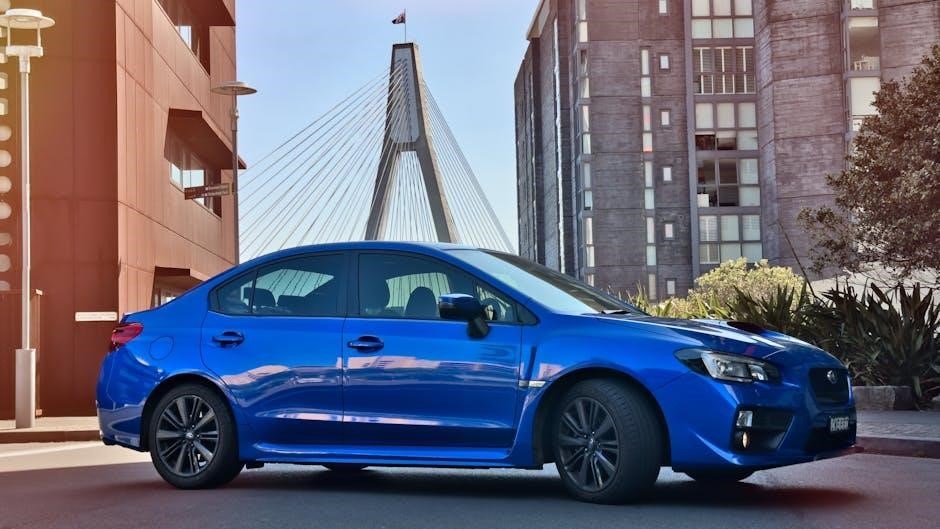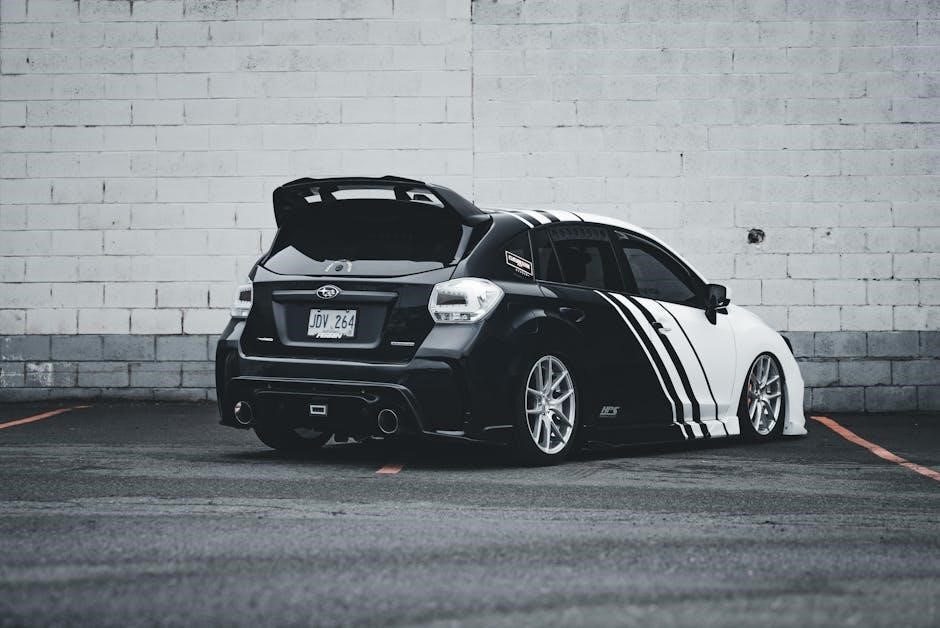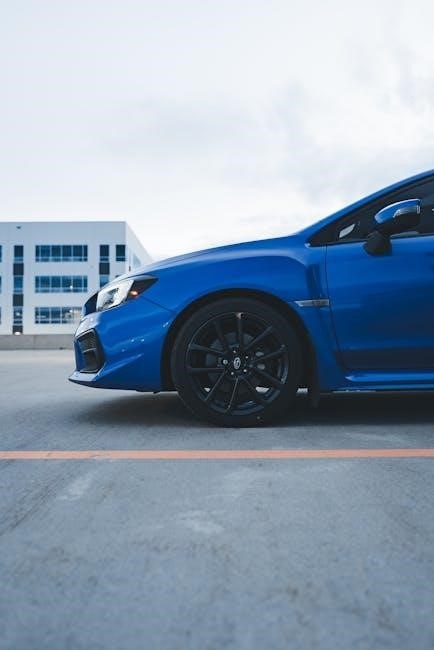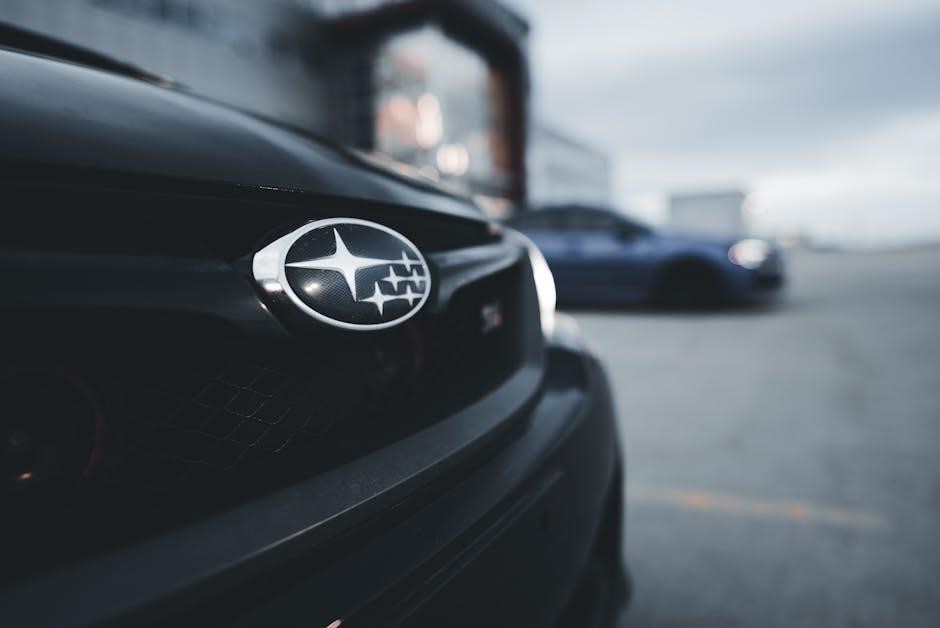The Subaru WRX is a high-performance car known for its rally heritage and all-wheel-drive capability. While historically associated with manual transmissions, modern WRX models now offer automatic options, catering to diverse driver preferences and needs.
Overview of the Subaru WRX Model
The Subaru WRX is a performance-oriented car with a rich rally heritage, known for its all-wheel-drive system and turbocharged flat-four engine. Initially introduced as a sporty trim of the Impreza, the WRX became a standalone model in 2015. It combines practicality with exhilarating driving dynamics, making it a favorite among enthusiasts. The WRX features a sport-tuned suspension, aggressive styling, and advanced driver-assistance technologies. While historically linked to manual transmissions, modern iterations offer automatic options to cater to a broader audience. Its evolution reflects Subaru’s commitment to balancing performance and everyday usability, ensuring the WRX remains a compelling choice for both enthusiasts and commuters alike.
Historical Context of the WRX
The Subaru WRX traces its roots to the early 1990s, emerging as a high-performance variant of the Impreza. Initially called the Impreza Turbo, it gained popularity in rally racing, which shaped its identity. The WRX name became synonymous with Subaru’s rally success, emphasizing turbocharged power and all-wheel-drive prowess. Early models were predominantly manual, catering to enthusiasts who valued driver engagement. Over the years, Subaru expanded the WRX lineup, introducing sedan and wagon options. By 2015, the WRX officially separated from the Impreza, solidifying its status as a standalone performance model. This historical evolution underscores the WRX’s transformation from a niche rally car to a versatile, everyday performance vehicle, maintaining its core appeal while adapting to modern automotive trends.


Are All Subaru WRX Manual?
No, not all Subaru WRX models are manual. While historically known for manual transmissions, modern WRX offerings include automatic options, broadening their appeal to various drivers.
Current Subaru WRX Transmission Options

The current Subaru WRX offers a choice between a standard 6-speed manual transmission and an optional CVT (Continuously Variable Transmission) for automatic driving. The manual gearbox is favored by driving enthusiasts for its precise control and sporty feel, while the CVT provides smooth, seamless acceleration, ideal for daily commuting. Both transmissions are paired with Subaru’s Symmetrical All-Wheel Drive system, ensuring enhanced traction and stability on various road conditions. The availability of these options allows potential buyers to choose based on their preferences, whether prioritizing performance, convenience, or a balance of both. This versatility makes the WRX appealing to a broader range of drivers.
Historical Transmission Options in WRX Models
The Subaru WRX has historically been known for its manual transmissions, but automatic options have been available in certain models. Early WRX generations, such as the GC8 and GD models, primarily featured 5-speed manual transmissions, with some automatic variants introduced later. The 6-speed manual became standard in later models, offering better gear ratios for performance. Automatic transmissions, including older 4-speed units and later CVT options, were added to cater to a broader audience. While manuals dominated the lineup, automatics were included to balance performance with convenience, reflecting Subaru’s effort to adapt to market demands while maintaining the WRX’s sporty identity. This historical balance has shaped the WRX’s appeal across different driver preferences.
Exceptions to the Manual Transmission in WRX
While the Subaru WRX is famously associated with manual transmissions, there have been exceptions. In 2015, Subaru introduced a continuously variable transmission (CVT) option for the WRX, paired with the FA20 2.0-liter turbocharged engine. This was aimed at appealing to drivers who prioritized convenience and fuel efficiency over manual shifting. Additionally, certain special editions and trims, such as the WRX Hybrid in some markets, featured automatic or CVT options to cater to a broader audience. These exceptions reflect Subaru’s effort to balance performance with practicality, ensuring the WRX remains accessible to a diverse range of drivers while maintaining its sporty heritage. These automatic variants, however, have historically been less popular among enthusiasts.
Benefits of Manual Transmission in the WRX

Benefits of Manual Transmission in the WRX
The manual transmission in the Subaru WRX enhances driving engagement, offering precise control and a direct connection to the vehicle’s performance capabilities. It also ensures optimal acceleration and fuel efficiency, making it a preferred choice for enthusiasts seeking an immersive driving experience.

Performance Advantages of Manual Transmission
The manual transmission in the Subaru WRX delivers superior performance by allowing drivers to exploit the engine’s full potential. With precise control over gear shifts, drivers can optimize acceleration and maintain torque delivery during cornering. The manual gearbox enables faster shifting compared to automatic systems, particularly in sporty driving scenarios. Additionally, the lack of a torque converter in manual transmissions reduces power loss, resulting in more direct power transfer to the wheels. This setup enhances responsiveness and agility, making the WRX more engaging on both road and track. The manual transmission’s performance advantages are particularly noticeable in dynamic driving conditions, where quick and deliberate shifts can significantly improve handling and speed.
Driver Engagement and Control with Manual
The manual transmission in the Subaru WRX enhances driver engagement by providing a more tactile and interactive driving experience. The clutch pedal and gearshift allow drivers to feel a direct connection to the vehicle, fostering a sense of control and precision. Manual shifting enables drivers to anticipate and respond to road conditions intuitively, making the driving process more immersive. This level of involvement is particularly rewarding for enthusiasts who value the hands-on nature of driving. Additionally, manual transmissions often require more skill and attention, which can heighten the sense of accomplishment and satisfaction behind the wheel. For many, the manual WRX embodies the spirit of driving as an active, engaging activity rather than a passive one.
Cost Efficiency of Manual Transmission
The manual transmission in the Subaru WRX offers notable cost efficiencies for drivers. Typically, manual versions of the WRX are priced lower than their automatic counterparts, making them a more affordable option for buyers. Additionally, manual transmissions generally achieve better fuel economy in real-world driving conditions, which can lead to long-term savings on fuel costs. Maintenance and repair expenses for manual transmissions are often lower as well, due to their simpler design compared to automatics. Furthermore, manual vehicles tend to retain better resale value, especially among driving enthusiasts who prioritize the manual driving experience. These factors make the manual WRX a financially appealing choice for those seeking a performance-oriented vehicle without compromising on cost efficiency.

Automatic Transmission in the WRX
The Subaru WRX offers an optional automatic transmission, providing a smoother and more convenient driving experience compared to the standard manual version.
Availability of Automatic Transmission in WRX
The Subaru WRX offers an automatic transmission option, catering to drivers who prefer convenience without sacrificing performance. Introduced in 2015, the WRX CVT (Continuously Variable Transmission) provides smooth acceleration and ease of use. While the manual gearbox remains standard, the automatic is available as an option, particularly in higher trims. This allows Subaru to appeal to a broader audience, including those who value comfort and ease in daily driving. The automatic transmission complements the WRX’s all-wheel-drive system, ensuring consistent power delivery. Subaru’s decision to include an automatic option reflects modern market demands, balancing performance with practicality for everyday use.
Performance Implications of Automatic Transmission
The Subaru WRX with an automatic transmission delivers solid performance but differs from its manual counterpart. The CVT (Continuously Variable Transmission) prioritizes smoothness and ease of use, which can result in slightly slower acceleration compared to the manual model. While the automatic WRX still offers respectable power delivery, the lack of direct gear control may reduce the sporty feel some drivers expect. However, the CVT is well-suited for everyday driving, providing seamless power delivery and minimal lag. For enthusiasts seeking maximum engagement, the manual remains the preferred choice, but the automatic is a practical option for those balancing performance with comfort.
Target Audience for Automatic WRX
The automatic Subaru WRX is primarily aimed at drivers who prioritize convenience and ease of use without sacrificing performance. This includes commuters who navigate heavy traffic or urban environments, where manual shifting can be less practical. Additionally, the automatic WRX appeals to those who may not be as familiar or comfortable with manual transmissions but still desire the sporty DNA of the WRX. It also caters to older drivers or those with physical constraints that make manual shifting less accessible. The automatic option broadens the WRX’s appeal, making it more approachable for a wider audience while maintaining its performance credentials for everyday driving scenarios.
Driving Experience Comparison
The Subaru WRX offers distinct driving experiences based on transmission choice. Manual models deliver precise control and tactile engagement, appealing to driving enthusiasts, while automatics prioritize smoothness and convenience, catering to everyday comfort and ease of use.
Manual vs. Automatic: Driving Dynamics
The Subaru WRX offers two distinct driving experiences with its manual and automatic transmission options. The manual transmission provides precise control and driver engagement, ideal for enthusiasts who enjoy the tactile feel of shifting gears and the ability to optimize acceleration and handling on winding roads or racetracks. In contrast, the automatic transmission prioritizes convenience and smoothness, making it suitable for everyday commuting and heavy traffic scenarios. While the manual version delivers quicker shifts and better performance, the automatic option offers ease of use and reduced driver fatigue. Both transmissions cater to different preferences, allowing drivers to choose based on their lifestyle and driving habits.

Acceleration and Handling Differences
The Subaru WRX with a manual transmission typically accelerates faster than its automatic counterpart, thanks to precise gear control and the ability to optimize power delivery. The manual version allows drivers to exploit the engine’s power band more effectively, particularly during spirited driving or on twisty roads. In contrast, the automatic transmission, while smoother, introduces a slight delay in acceleration due to torque converter engagement. Handling-wise, both transmissions deliver the WRX’s signature agility, but the manual fosters a more connected driving experience, enabling quicker shifts and better control during cornering. The automatic, however, provides a more relaxed driving experience with adaptive modes to suit varying conditions.
Real-World Performance Metrics
In real-world driving, the Subaru WRX with a manual transmission delivers sharper acceleration and more responsive handling compared to its automatic counterpart. The manual WRX achieves a 0-60 mph time of approximately 5.4 seconds, while the automatic CVT model is slightly slower, around 5.9 seconds. Fuel economy differs marginally, with the manual offering 21 MPG combined (19 city, 25 highway) and the automatic achieving 22 MPG combined (20 city, 24 highway). The manual transmission’s direct driver input enhances precision during cornering, making it a favorite for enthusiasts. Conversely, the automatic provides smoother power delivery, which can be advantageous in stop-and-go traffic or for less experienced drivers. Both variants maintain the WRX’s reputation for balanced performance and practicality.
Enthusiast Perspective on WRX Transmissions
Enthusiasts overwhelmingly favor the manual Subaru WRX for its precise control, driving engagement, and sporty feel, making it a hallmark of the WRX experience.
Community Feedback on Manual vs. Automatic
The Subaru WRX community predominantly favors manual transmissions, praising their direct driver engagement and sporty feel, which align with the car’s rally heritage.
Manual enthusiasts emphasize the precision and control it offers, making it a defining feature of the WRX experience. However, some owners appreciate the convenience of automatic transmissions.
Automatic models are seen as more practical for daily driving, especially in heavy traffic, though purists argue they dilute the car’s performance-oriented nature.
Overall, the community reflects a clear preference for manual transmissions, but acknowledges the growing demand for automatic options among broader audiences.
Impact of Transmission Choice on Resale Value
The transmission choice significantly impacts the resale value of the Subaru WRX. Manual transmissions are highly sought after by enthusiasts and collectors, often retaining higher value compared to automatic models.
Manual WRXs are perceived as more authentic to the car’s rally heritage, making them more desirable in the used market. In contrast, automatic transmissions, while practical, may appeal to a broader audience but tend to depreciate slightly faster.
Market trends show that manual WRXs generally command higher resale prices, especially in performance-oriented trims like the STI. However, well-maintained automatic models can still hold their value, particularly in regions where convenience is prioritized.
Ultimately, the transmission choice influences resale value, but other factors like mileage, condition, and optional features play a larger role in determining the car’s worth.
Modification Preferences Among Enthusiasts
Subaru WRX enthusiasts often prioritize modifications that enhance performance and personalization. Engine tuning, turbo upgrades, and suspension modifications are popular for improving speed and handling. Many opt for lightweight components and aerodynamic body kits to enhance both aesthetics and functionality.
Manual transmission WRXs are frequently modified with upgraded clutches and short shifters for better driver engagement. Exhaust systems are also commonly upgraded to increase horsepower and achieve a sportier sound. Interior upgrades, such as sport seats and aftermarket infotainment systems, are favored for comfort and style.
While automatic models can be modified, they are less common in the enthusiast community compared to manual versions. Overall, modifications reflect individual preferences, blending performance, style, and driving enjoyment.

Maintenance and Reliability
Regular maintenance is key for the Subaru WRX, including synthetic oil changes and brake inspections. Subaru’s all-wheel-drive system requires periodic alignment checks and drivetrain inspections. Turbocharged engines demand careful monitoring of cooling systems and boost pressure. While Subarus are known for reliability, excessive wear on clutch and gearbox components can occur in manual models due to aggressive driving. Proper servicing ensures longevity and optimal performance, aligning with Subaru’s reputation for durability and ruggedness.
Maintenance Requirements for Manual WRX
Manual Subaru WRX models require specific maintenance to ensure optimal performance and longevity. Regular clutch inspections are essential, as aggressive driving can reduce its lifespan. Replacing the clutch every 50,000 to 100,000 miles is common, depending on usage; Gearbox oil changes are recommended every 30,000 to 60,000 miles to maintain smooth shifting and prevent wear. Additionally, the drivetrain and all-wheel-drive system benefit from periodic inspections to ensure proper alignment and functionality. Drivers should also monitor the transmission mounts and bushings, as they can degrade over time. Adhering to these maintenance routines helps preserve the WRX’s performance capabilities and prevents costly repairs down the line.
Reliability of Manual vs. Automatic Transmissions

The reliability of manual and automatic transmissions in the Subaru WRX varies based on usage and maintenance. Manual transmissions are often considered more durable due to fewer complex components, but they can experience wear on synchronizers and the clutch over time, especially with aggressive driving. Automatic transmissions, while more convenient, rely on advanced electronics and hydraulic systems, which can be prone to failure if not properly maintained. Subaru’s CVT (Continuously Variable Transmission) in automatic models has historically faced criticism for reliability issues, though recent models have shown improvement. Overall, both transmissions can be reliable, but proper care and adherence to maintenance schedules are crucial for long-term performance.
Common Issues with WRX Transmissions
Common issues with Subaru WRX transmissions vary between manual and automatic models. Manual transmissions can experience synchronizer wear, particularly in older models, leading to grinding or difficulty shifting gears. The clutch may also wear prematurely with aggressive driving. For automatic models, especially those with CVT, issues like hesitation, jerking, or unexpected RPM spikes have been reported. These problems are often linked to software updates or faulty torque converters. Additionally, some WRX models have experienced transmission slipping or failure to engage gears properly, particularly under high-stress conditions. Regular maintenance and timely repairs are essential to prevent these issues from escalating, ensuring optimal performance and longevity of the transmission system.
The Subaru WRX offers both manual and automatic transmissions, catering to various driving preferences while maintaining its performance legacy and broad enthusiast appeal today successfully.
Final Thoughts on WRX Transmission Options
The Subaru WRX offers a compelling blend of performance and practicality, with both manual and automatic transmissions available to suit different driving styles and preferences.
While the manual transmission remains a favorite among enthusiasts for its direct control and sporty feel, the automatic option provides convenience and ease of use, particularly in urban or heavy traffic conditions.
Subaru has successfully catered to a broad audience by offering choices, ensuring the WRX remains accessible to both performance-driven purists and everyday commuters.
Ultimately, the decision between manual and automatic hinges on personal preference and lifestyle, with both options delivering the signature WRX experience.
Recommendations for Potential Buyers
Potential buyers of the Subaru WRX should consider their lifestyle and preferences when choosing between manual and automatic transmissions.
For enthusiasts seeking maximum control and driving engagement, the manual transmission is highly recommended, as it enhances the sporty character of the WRX.
However, those prioritizing convenience and ease of use, especially in urban or traffic-heavy environments, may find the automatic transmission more practical.
Test driving both options is advisable to determine the best fit.
Additionally, resale value and long-term satisfaction should be considered, as manual transmissions often appeal more to performance-oriented buyers.
Ultimately, the choice should align with the driver’s needs and preferences for an optimal ownership experience.